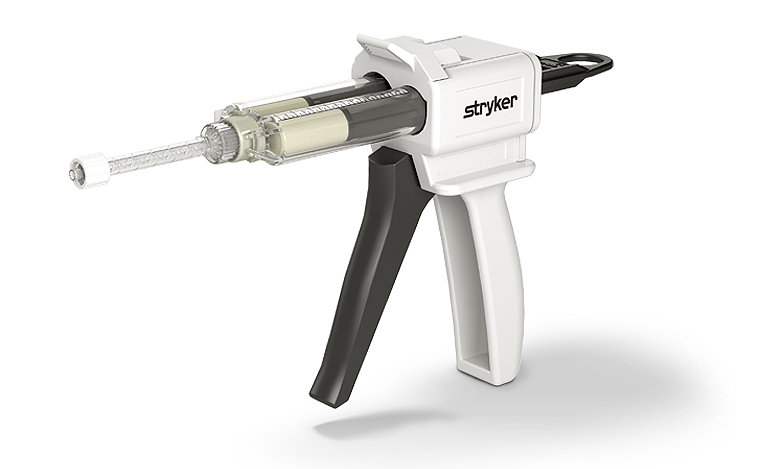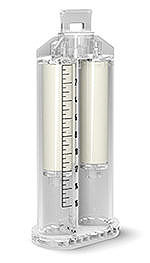Cortoss bone augmentation material
Cortoss material was developed to provide an ideal bone augmentation solution for treatment of vertebral compression fractures (VCFs).

Features
Cortoss is an advanced, injectable, synthetic, non-resorbable biomaterial which mimics the mechanical properties of cortical (weightbearing) bone1. It has been clinically proven to match the safety and effectiveness of Polymethylmethacrylate (PMMA) for vertebral augmentation.2
- Flow and fill: properties improve short-term pain and long-term function2
- Safety: low incidence of adjacent fractures2; minimal exotherm3 and monomer release4
- Control: procedural flexibility with mix-on-demand and start/stop delivery5
- Robust compilation of clinical data2,6,7

Multi-center clinical trials provide the proof:
- The safety and efficacy of Cortoss material has been demonstrated in three U.S. clinical investigations and multiple European studies.2,6,7
- In patients with a first-time fracture at one level, there was a 43% reduction in adjacent level fractures in the patient population that used Cortoss material2,1
In patients with a first-time fracture at one level, there was a 43% reduction in adjacent level fractures in the patient population that used Cortoss material21In patients with a first-time fracture at one level, there was a 43% reduction in adjacent level fractures in the patient population that used Cortoss material21 - Compared to PMMA, Cortoss material is more hydrophilic, which enables it to coat and augment the internal structure of the vertebral body.2 This interdigitating characteristic resulted in a 30% reduction in material injected when compared to PMMA in a controlled study2
- The level 1 IDE Study showed a statistically significant increase in the percentage of patients experiencing a reduction in short-term pain at 3 months and improvement of long-term function at 24 months2
The level 1 IDE Study showed a statistically significant increase in the percentage of patients experiencing a reduction in short-term pain at 3 months and improvement of long-term function at 24 months2
Warning/adverse events
Serious adverse events, some with fatal outcome, associated with the use of bone cements for vertebroplasty, kyphoplasty and sacroplasty include myocardial infarction, cardiac arrest, cerebrovascular accident, pulmonary embolism, and cardiac embolism. Although it is rare, some adverse events have been known to occur up to one year post-operatively. Additional risks exist with the use of bone cement. Please see the IFU for a complete list of potential risks.
- An Evaluation of the Safety and Efficacy of an Alternative Material to Polymethylmethacrylate Bone Cement for Vertebral Augmentation
- Bae, H., et al, A Prospective Randomized FDA-IDE Trial Comparing Cortoss to PMMA for Vertebroplasty: A Comparative Effectiveness Research Study with 24-Months Follow-Up. Spine, first published on July 5, 2011 as doi: 10.1097/ BRS.0b013e31822ba50b.
- Deramond H, Wright NT, Belko‑ SM. Temperature elevation caused by bone cement polymerization during vertebroplasty. Bone, 1999. Vol 25 (2) 17S-21S.
- Pomrink, et al., Evaluation of the reaction kinetics of Cortoss, a thermoset cortical bone void ller. Biomaterials, 2003, Vol. 24 (6) 1023-1031.
- Cortoss Bone Augmentation Material: Instructions for Use (IFU)
- Palussière, Jean et al. "Clinical Results Of An Open Prospective Study Of A Bis-GMA Composite In Percutaneous Vertebral Augmentation". European Spine Journal 14.10 (2005): 982-991. Web. 18 Aug. 2016.
- Bae, Hyun et al. "Clinical Experience Using Cortoss For Treating Vertebral Compression Fractures With Vertebroplasty And Kyphoplasty". Spine 35.20 (2010): E1030-E1036. Web. "Clinical Experience Using Cortoss For Treating Vertebral Compression Fractures With Vertebroplasty And Kyphoplasty". Spine 35.20 (2010): E1030-E1036. Web.
1000-025-852 Rev None
